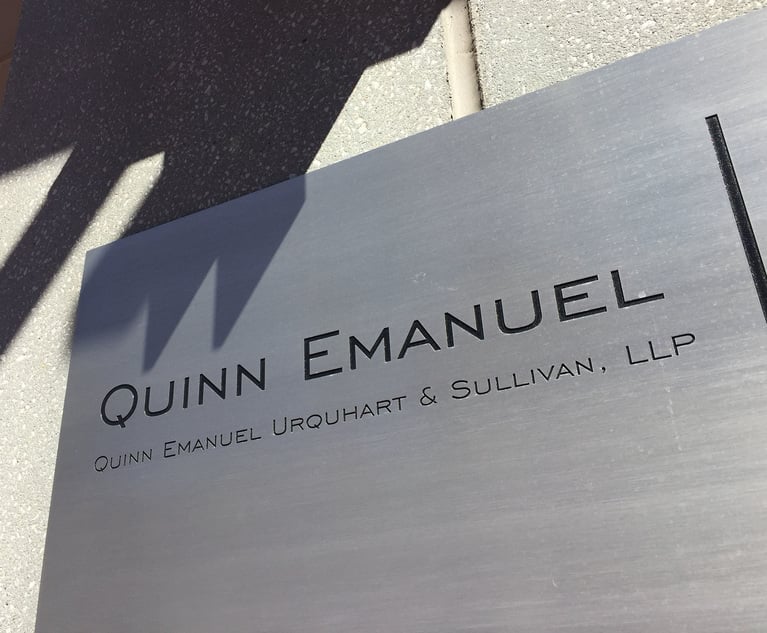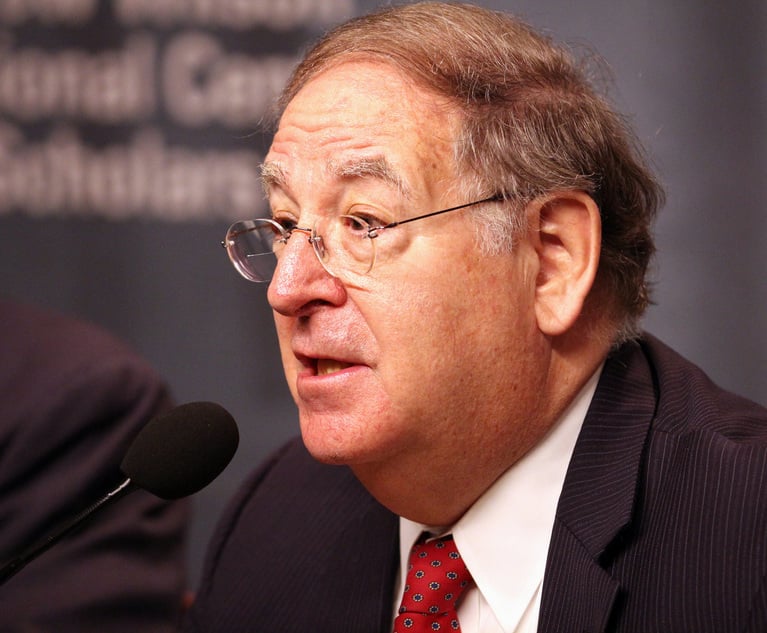Judge Considers Legality of PACER Fees
U.S. District Judge Ellen Huvelle will decide whether PACER is charging inordinately high fees and putting the revenue toward unauthorized uses.
March 23, 2018 at 06:20 PM
4 minute read

A federal district court heard arguments Friday on whether the federal courts are inappropriately overcharging for public access to court documents to fund certain projects.
U.S. District Judge Ellen Huvelle is considering a class-action lawsuit, filed by the National Veterans Legal Services Program, the National Consumer Law Center and Alliance for Justice, that alleges the Administrative Office of the U.S. Courts overcharges for online access to dockets and documents via the Public Access to Court Electronic Records system. The judge appeared skeptical of both parties in Friday's hearing, which centered on whether the courts can fund only PACER, or broader public access programs, with the fees.
Huvelle certified the class, which includes anyone who paid PACER fees between 2010 and 2016. PACER currently charges 10 cents per page, with a maximum of $3 for “any case document, docket sheet, or case-specific report.”
The plaintiffs argue those prices far exceed the marginal cost for the PACER program, and are illegally used to pay for the Case Management/Electronic Case Files system (CM/ECF), which litigants use to file documents. The fees are also used for other programs, such as victim notifications under the Violent Crime Control Act and e-juror services.
The 2002 E-Government Act authorizes courts to only charge PACER fees that reimburse the cost of providing the service, the plaintiffs allege. The government says the courts can spend PACER fee revenue on public access services as it deems necessary.
In the roughly three-hour long hearing Friday, Huvelle questioned whether costs associated with the CM/ECF system are, in reality, costs associated with PACER. Gupta Wessler's Jonathan Taylor, a lawyer for the plaintiffs, said that the CM/ECF system is used for filing documents, whereas PACER is separate, and makes the documents available for the public.
However, the judge said it appeared PACER was simply a portal, and that those who pay only for PACER are actually paying for access to the documents filed and maintained via CM/ECF.
“The PACER people, if there was no ECF, they wouldn't get much,” the judge said.
Huvelle also questioned the government's assertion that certain programs count as public access programs, such as jury notifications or the victim notifications.
Brian Field, a lawyer for the government, said those programs are often operated through mechanisms in the CM/ECF system, and are also sent to members of the public. He said the law does not require that the programs benefit the entire public, but rather members of the public.
“I don't understand how far you allow the definition of public program to be stretched,” Huvelle said.
Field also said the judiciary submitted its 2007 financial plan to both the House and Senate Appropriations committees, which said there would be an “expanded use” of the PACER fees. Some members of the committees then sent letters to the AO saying they had no objection to the plans as a whole, but did not specifically mention the expanded use of the fees.
While Field said that was evidence of Congress' approval of how the fees were being used, Huvelle was skeptical. She asked if there was any case that showed she could use the lawmakers' letters that way in making a decision. Field said he did not have an example, and she said that if he found one, he could let her know within 24 hours.
This content has been archived. It is available through our partners, LexisNexis® and Bloomberg Law.
To view this content, please continue to their sites.
Not a Lexis Subscriber?
Subscribe Now
Not a Bloomberg Law Subscriber?
Subscribe Now
NOT FOR REPRINT
© 2025 ALM Global, LLC, All Rights Reserved. Request academic re-use from www.copyright.com. All other uses, submit a request to [email protected]. For more information visit Asset & Logo Licensing.
You Might Like
View All
Trump Administration Faces Legal Challenge Over EO Impacting Federal Workers
3 minute read
Private Equity Giant KKR Refiles SDNY Countersuit in DOJ Premerger Filing Row
3 minute read
Quinn Emanuel Files Countersuit Against DOJ in Row Over Premerger Reporting
3 minute read
'Thoughtful Jurist': Maryland US District Senior Judge Messitte Dies After Short Illness
4 minute readTrending Stories
Who Got The Work
J. Brugh Lower of Gibbons has entered an appearance for industrial equipment supplier Devco Corporation in a pending trademark infringement lawsuit. The suit, accusing the defendant of selling knock-off Graco products, was filed Dec. 18 in New Jersey District Court by Rivkin Radler on behalf of Graco Inc. and Graco Minnesota. The case, assigned to U.S. District Judge Zahid N. Quraishi, is 3:24-cv-11294, Graco Inc. et al v. Devco Corporation.
Who Got The Work
Rebecca Maller-Stein and Kent A. Yalowitz of Arnold & Porter Kaye Scholer have entered their appearances for Hanaco Venture Capital and its executives, Lior Prosor and David Frankel, in a pending securities lawsuit. The action, filed on Dec. 24 in New York Southern District Court by Zell, Aron & Co. on behalf of Goldeneye Advisors, accuses the defendants of negligently and fraudulently managing the plaintiff's $1 million investment. The case, assigned to U.S. District Judge Vernon S. Broderick, is 1:24-cv-09918, Goldeneye Advisors, LLC v. Hanaco Venture Capital, Ltd. et al.
Who Got The Work
Attorneys from A&O Shearman has stepped in as defense counsel for Toronto-Dominion Bank and other defendants in a pending securities class action. The suit, filed Dec. 11 in New York Southern District Court by Bleichmar Fonti & Auld, accuses the defendants of concealing the bank's 'pervasive' deficiencies in regards to its compliance with the Bank Secrecy Act and the quality of its anti-money laundering controls. The case, assigned to U.S. District Judge Arun Subramanian, is 1:24-cv-09445, Gonzalez v. The Toronto-Dominion Bank et al.
Who Got The Work
Crown Castle International, a Pennsylvania company providing shared communications infrastructure, has turned to Luke D. Wolf of Gordon Rees Scully Mansukhani to fend off a pending breach-of-contract lawsuit. The court action, filed Nov. 25 in Michigan Eastern District Court by Hooper Hathaway PC on behalf of The Town Residences LLC, accuses Crown Castle of failing to transfer approximately $30,000 in utility payments from T-Mobile in breach of a roof-top lease and assignment agreement. The case, assigned to U.S. District Judge Susan K. Declercq, is 2:24-cv-13131, The Town Residences LLC v. T-Mobile US, Inc. et al.
Who Got The Work
Wilfred P. Coronato and Daniel M. Schwartz of McCarter & English have stepped in as defense counsel to Electrolux Home Products Inc. in a pending product liability lawsuit. The court action, filed Nov. 26 in New York Eastern District Court by Poulos Lopiccolo PC and Nagel Rice LLP on behalf of David Stern, alleges that the defendant's refrigerators’ drawers and shelving repeatedly break and fall apart within months after purchase. The case, assigned to U.S. District Judge Joan M. Azrack, is 2:24-cv-08204, Stern v. Electrolux Home Products, Inc.
Featured Firms
Law Offices of Gary Martin Hays & Associates, P.C.
(470) 294-1674
Law Offices of Mark E. Salomone
(857) 444-6468
Smith & Hassler
(713) 739-1250










